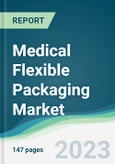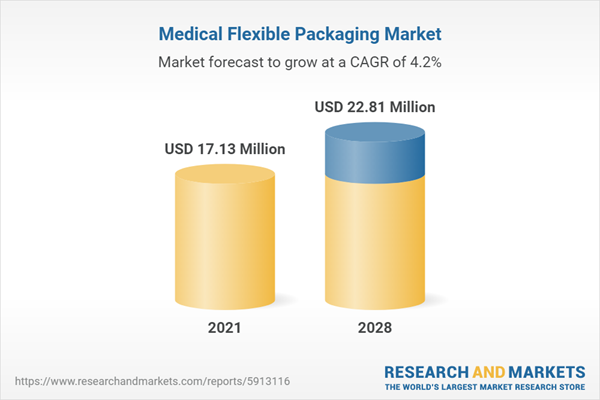The global medical flexible packaging market was valued at US$17.125 million in 2021 and is expected to grow at a CAGR of 4.18% during the forecast period.
Medical flexible packaging refers to specialized packaging materials and designs used in the healthcare industry to preserve and protect medical products and devices. These packages are typically made from flexible materials like films, foils, and laminates that provide barrier properties, ensuring the integrity and sterility of the contents. Medical flexible packaging plays a crucial role in safeguarding pharmaceuticals, medical equipment, and supplies, keeping them safe from contamination, moisture, light, and other external factors that could compromise their quality and efficacy. Additionally, it often includes features such as tamper-evident seals and labelling for proper identification and traceability, ensuring patient safety and regulatory compliance.Introduction:
The medical flexible packaging market refers to the industry that deals with the production and distribution of packaging materials specifically designed for medical and healthcare applications. The market encompasses a wide range of products, including pouches, bags, films, blister packs, and wraps, tailored to meet the unique requirements of medical devices, pharmaceuticals, and other healthcare products. The medical flexible packaging market caters to industries such as pharmaceuticals, medical devices, biotechnology, and healthcare supplies. It provides packaging solutions for medications, medical devices, biopharmaceuticals, and healthcare consumables, ensuring their safety, sterility, and integrity.This market has been growing significantly due to the rising demand for safe and reliable packaging solutions in the healthcare sector. Factors such as the increasing global population, ageing demographics, advancements in medical technology, and stringent regulations regarding product safety and quality have fuelled the demand for medical flexible packaging.:
Growing Healthcare Industry:
The expanding healthcare industry, driven by factors such as the increasing global population, ageing demographics, and the prevalence of chronic diseases, fuels the demand for medical products and devices. This, in turn, drives the need for reliable and safe packaging solutions to protect and preserve these healthcare products.Stringent Regulatory Standards:
The healthcare sector is subjected to strict regulations and quality standards to ensure patient safety and product efficacy. Regulatory bodies, such as the FDA (Food and Drug Administration) in the United States, mandate specific packaging requirements for pharmaceuticals and medical devices. For instance, last year the FDA issued guidance for flexible packaging used in human drugs and medical devices. It offers recommendations on design, manufacturing, and testing to ensure compliance with FDA safety and effectiveness requirements. Compliance with these regulations drives the demand for specialized medical flexible packaging that meets the necessary standards.Emphasis on Product Protection and Safety:
Healthcare products, including pharmaceuticals and medical devices, are sensitive and prone to damage from factors like moisture, light, and contamination. Medical flexible packaging provides a barrier against these elements, protecting the integrity of the products and ensuring their safety throughout the supply chain.Technological Advancements:
Advancements in packaging technologies, such as improved barrier films, sterilization methods, and tamper-evident features, have enhanced the capabilities of medical flexible packaging. These innovations provide better product protection, extend shelf life, and improve usability, driving the adoption of such packaging solutions in the healthcare industry.Increasing Demand for Sterile Packaging:
Sterility is a critical requirement in the healthcare sector, particularly for pharmaceuticals, medical devices, and surgical instruments. Medical flexible packaging offers solutions for sterile packaging, providing an aseptic barrier that prevents contamination and maintains the sterility of the packaged products until they are used.Rise in Home Healthcare and E-commerce:
The increasing trend of home healthcare services and the growth of e-commerce in the healthcare sector have created a need for convenient, user-friendly, and efficient packaging solutions. Medical flexible packaging offers portability, ease of use, and customized packaging options for home healthcare products, while also meeting the requirements of online retail and direct-to-consumer distribution.Increasing Demand for Sustainable Packaging:
There is a growing awareness and preference for sustainable packaging solutions in the healthcare industry. Medical flexible packaging manufacturers are focusing on developing eco-friendly materials, and recyclable options, and reducing packaging waste. The demand for sustainable packaging drives innovation and adoption of eco-friendly solutions in the medical flexible packaging market.Shift towards Convenience and Patient-Centric Packaging:
There is a rising demand for patient-centric packaging solutions that prioritize convenience, ease of use, and patient compliance. Medical flexible packaging incorporates features like child-resistant closures, user-friendly designs, and dosage adherence aids to enhance patient experience and medication management.Positive growth in the pharmaceutical packaging segment:
The pharmaceutical packaging segment is witnessing a positive growth in the medical flexible packaging market. This is due to several factors, like the increasing demand for pharmaceutical products globally, the need for safe and tamper-evident packaging, and the growing emphasis on patient convenience and compliance. Pharmaceutical packaging in medical flexible packaging ensures product integrity, extends shelf life, facilitates accurate dosage administration, and provides clear labelling for vital information. Moreover, advancements in packaging technologies and the rise of personalized medicine further drive the growth of the pharmaceutical packaging segment in the medical flexible packaging market.The North American region is anticipated to grow at a high rate:
North America is estimated to hold a significant share of the medical flexible packaging market. This is primarily due to factors such as a well-established healthcare infrastructure, robust regulatory frameworks, and high healthcare expenditure in the region. The presence of major pharmaceutical and medical device manufacturers, coupled with a strong focus on product safety and quality, drives the demand for reliable and compliant packaging solutions. Additionally, increasing consumer awareness regarding healthcare and growing demand for innovative packaging technologies further contribute to North America's prominence in the medical flexible packaging market.Key Developments
- In January 2023, Nelipak, a leading packaging manufacturer, is using Eastman's EastarTM Renew 6763 to produce sterile barrier packaging for medical devices. This innovative material, powered by molecular recycling, diverts plastic waste from landfills while maintaining the same durability and performance as traditional co-polyester.
- In June 2022, Gufic Biosciences launched a new drug delivery system called dual-chamber bags. These bags consist of two chambers made of polypropylene (DEHP free) and have a peel-able aluminium foil, enabling the safe storage of unstable drugs. This innovation offers enhanced drug stability and improved patient safety.
Company Products
- Aseptic Flexible Packaging by Amcor: This packaging is designed to be sterile and is used to package a variety of medical products, including vaccines, blood products, and IV fluids.
- High Barrier Films by Constantia Flexibles: These films are designed to provide a high level of protection against moisture, oxygen, and light. They are used to package a variety of medical products, including tablets, capsules, and liquids.
- Sustainable packaging by WestRock: This packaging is made from recycled materials or renewable resources. It is used to package a variety of medical products, including bandages, gauze, and gloves.
- Child-Resistant Packaging by Essity: This packaging is designed to prevent children from opening it accidentally. It is used to package a variety of medical products, including medications and vitamins.
Segmentation
By Material
- Polyethylene
- Polyethylene Terephthalate
- Polypropylene
- Polyvinyl Chloride
- Others
By End-User
- Pharmaceutical Manufacturers
- Medical Device Manufacturers
- Implant Manufacturers
- Others
By Product Type
- Lids & Label
- Pouches & Bags
- Others
By Geography
- North America
- United States
- Canada
- Mexico
- South America
- Brazil
- Argentina
- Others
- Europe
- United Kingdom
- Germany
- France
- Italy
- Spain
- Others
- Middle East and Africa
- Saudi Arabia
- UAE
- Others
- Asia Pacific
- China
- Japan
- India
- South Korea
- Taiwan
- Thailand
- Indonesia
- Others
Table of Contents
1. INTRODUCTION
2. RESEARCH METHODOLOGY
3. EXECUTIVE SUMMARY
4. MARKET DYNAMICS
5. GLOBAL MEDICAL FLEXIBLE PACKAGING MARKET BY MATERIAL
6. GLOBAL MEDICAL FLEXIBLE PACKAGING MARKET BY END-USER
7. GLOBAL MEDICAL FLEXIBLE PACKAGING MARKET BY PRODUCT TYPE
8. GLOBAL MEDICAL FLEXIBLE PACKAGING MARKET BY GEOGRAPHY
9. COMPETITIVE ENVIRONMENT AND ANALYSIS
10. COMPANY PROFILES
Companies Mentioned
- Bemis Manufacturing Company
- WestRock Company
- Dätwyler Holding Inc.
- Catalent, Inc
- Coveris
- Winpak Ltd.
- CCL Healthcare
- Gerresheimer
- Mondi
- Amcor Group
Methodology

LOADING...
Table Information
| Report Attribute | Details |
|---|---|
| No. of Pages | 147 |
| Published | November 2023 |
| Forecast Period | 2021 - 2028 |
| Estimated Market Value ( USD | $ 17.13 Million |
| Forecasted Market Value ( USD | $ 22.81 Million |
| Compound Annual Growth Rate | 4.1% |
| Regions Covered | Global |
| No. of Companies Mentioned | 10 |









